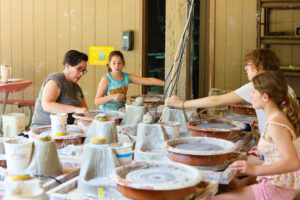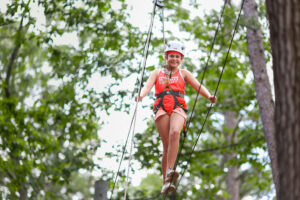 How do you build your camp day when there are so many activities to choose from? What if there are more than 50? What do you do?
How do you build your camp day when there are so many activities to choose from? What if there are more than 50? What do you do?
It’s complicated, according to camp directors.
You must balance many different priorities: camper safety, camper body rhythms, camper development, among others. During hot and often rainy summers, directors also must pay attention to the weather daily.
Three camp directors spoke about these challenges. Two, Eytan Graubart of Pinemere Camp in the Pocono Mountains of Pennsylvania and Victoria Anderson of YMCA Camp West Mar in the Catoctin Mountains of Maryland, lead overnight camps. Another, Sara Sideman of the JCC Camps at Medford, in South Jersey, directs a day camp.
For camps that offer electives or options for campers throughout the day, parents and kids can keep these considerations in mind when building their own camp day or week in Summer 2024.
Graubart
The Pinemere director believes in focusing on each day individually. Let’s say there’s an intercamp basketball game in the afternoon — that’s a very specific activity, Graubert explained. On that day, the campers playing in the game should take it easy in the morning.
But that’s only one very specific day.
There are also approaches for days in general, according to Graubart. For example, it’s often good to schedule high-energy activities before bedtime. That gets the last bit of energy out for campers before they wind down for bed.
There are other daily rules, too. Teen campers don’t have the same energy as younger campers in the morning. Active programs should not happen during the hottest part of the day. Schedule a rest hour after lunch so kids can digest.
Building a schedule is also a matter of developing campers. Camp, after all, takes the place of school during the summer.
If a camper is working on a skill at the ropes course, he or she might need to hone it for several days in a row. It’s also important to give kids some choice in this area. At Pinemere, campers have set schedules in the morning but electives in the afternoon.
“With so many activities offered, the biggest problem is often making sure campers’ days don’t vary too much so that they can truly develop some skills and passion for an area; so, we encourage a balance of repeat activities and new ones, daily,” Graubart said.

Anderson
At Camp West Mar, the setting plays a major role. Located in the Catoctin Mountains, the YMCA camp has trees, shade and lower temperatures. This allows directors to use the shade to their advantage in scheduling physically demanding activities.
But when the heat or sun does become an issue, Camp West Mar, like other camps, avoids those demanding activities or supplements them with water activities using water balloons, hoses, sponges and buckets.
Also, just like Graubart, Anderson believes in offering a rest hour after lunch.
When it comes to development, the Y camp tries to give kids space to explore, according to Anderson. This allows them to learn new skills and build self-esteem.
Campers participate in certain activities daily such as gaga (a variation of dodgeball) and swimming. But they also begin new activities in areas of curiosity.
“Our individual-centered activities often involve complex skill-building, such as fishing, archery or slingshot,” Anderson said. “Our group-centered activities focus on soft skill building, such as communication or problem-solving through team-building experiences or sports competitions.”
Sideman
Many successful camp experiences involve camper/family loyalty. The kids enjoy their experience so much that they come back year after year. The JCC Camps at Medford has been able to help kids develop over several years in this way, according to Sideman.
“The JCC Camps at Medford has an aspirational arc to our program experience so that campers can grow in independence each summer that they spend with us,” she said.
The JCC Camps’ youngest kids are in pre-K through first grade. Sideman and her team build schedules for those kids because they are so young.
“They get a liberal arts camp experience with a taste of every type of activity offered for their age group — a variety of sports, cooking, arts, music and more,” she said. “We aim to have their days be a mixture of both active and sedentary activities. We don’t want campers that age on the sports field all day or sitting under a pavilion all day. The mixture allows for a well-rounded day with periods of rest in between bursts of activity.”
As campers grow into grades 2 to 4, they start picking a few electives each week, Sideman said.
“Which allows them to take a deeper dive into the activities that interest them most,” she says. “Each year of this age group, they pick a few more electives, which prepares them for entering fifth grade.”
By grades 5 to 8, campers have an elective schedule, according to Sideman. In the spring, they are sent a list of activities offered for their age group. There are almost 100 options, including lake inflatables, archery, sports, wheel ceramics and jewelry making.
One recommendation, so that kids can learn the valuable life lesson of commitment, is to choose activities that require a multi-day commitment, such as musical theater or a sports league. But there is also value in selecting unfamiliar activities to push campers to grow.
“We love to see how our campers choose and hone their interests, but we also love that most of our campers try something new and out of their comfort zone each summer,” Sideman said. “Camp is such a safe space to try new things.”






